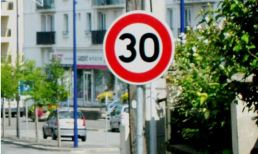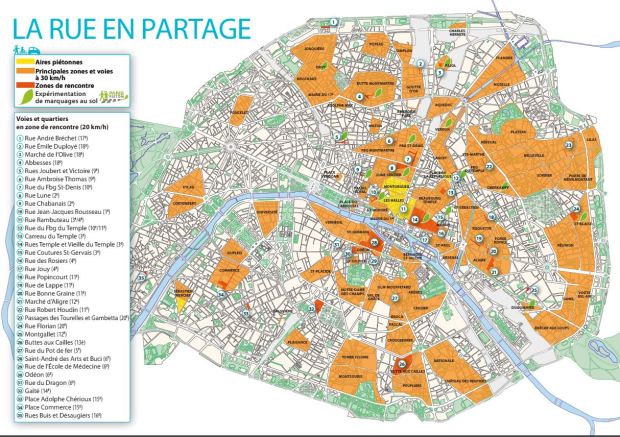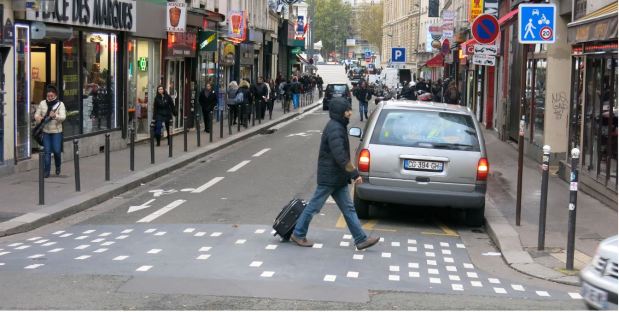 The just-elected new Mayor of Paris, Madame Anne Hidalgo, has prepared a revolutionary sustainable mobility project whereby virtually all of the streets of the city will be subject to a maximum speed limit of 30 km/hr.
The just-elected new Mayor of Paris, Madame Anne Hidalgo, has prepared a revolutionary sustainable mobility project whereby virtually all of the streets of the city will be subject to a maximum speed limit of 30 km/hr.
The only exceptions in the plan are a relatively small number of major axes into the city and along the two banks of the Seine, where the speed limit will be 50 km/hr, and the city’s hard pressed ring road (périphérique) where the top permissible speed has recently been reduced from 80 to 70 km/hr. At the other end of the slowth spectrum are a certain number of “meeting zones” (zones de rencontre) spotted around the city in which pedestrians and cyclists have priority but mix with cars which are limited to a top speed of 20 km/hr. A veritable révolution à la française.
This major policy initiative has not however taken place overnight, since for some years now there has been a steady increase in the number of zones reserved for pedestrians only, and more recently a step-by-step movement to “eco-areas” (see http://www.eco-quartiers.fr) where top speeds are already limited to 30 km/hr. By 2013 some 560 kilometers of the city streets were already in such areas, about one third of the total. (See map; click to enlarge.)
Once the plan has been approved by the Municipal Council, where the mayor holds the majority, that entire map of e city will be transformed.
What is notable about this approach?
Across-the-board sustainability improvements:
As traffic speeds are significantly brought down across the city, a number of very important things occur as a direct result: substantially fewer accidents, significant reduction in serious injuries and deaths, energy savings, reduce dependence on imported fossil fuels, local air pollution reduction, quality-of-life improvements all those who live and work, and play and study there, improved conditions and local accessibility for local business, significantly reduced carbon stress on climate, and the long list goes on.
Uniform Driving Environment / New Mental Maps
As opposed to most of our cities which today are a veritable patchwork of different speed sections which are confusing to the driver as well is difficult to enforce, the creation of a uniform driving environment offers numerous advantages. It becomes much easier for drivers to respect speed limits where they are not confronted with continuous and confusing changes from street to street, where even the conscientious citizen can find themselves not always respecting the letter of the law. So in this respect, simplicity and clarity are among its significant contributions, in helping drivers develop a new and easier to understand mental map for moving about the city.
“Flooding the market”
For the most part public policies in the field of sustainable mobility tend to be conservative and in the early stages start small. For example shared bicycle projects which for years consisted of tens of at the most 100 or 200 shared bicycles on the city streets, and then one day — actually exactly nine years ago this week — the city of Lyon put two thousand public bicycles on the streets of a city that was not exactly cycle friendly, and thereby created the equivalent of a shock effect which brought cycling in Lyon into a leadership position. (And of course opening up the competition for mega-public bike projects which are so exciting, important and transformative today.)
“Flooding the market” is a strategy which basically changes the rules of the game and alters perceptions in the process. This is definitely what the city of Paris and their new Mayor are doing by extending 30 kph zone to the entire city.
Politically astute:
The other thing that Mayor Hidalgo has been so well is to take a strong initiative at the very beginning of her mandate. There will be a thousand voices raised against it, as is always the case when any significant transformative measures put in place, but this is the time to get a project as ambitious as this up and running. There will be possibilities for fine-tuning an adjustment over the remainder of this first mandate.
Continuity
One of the most important characteristics of sustainable public policies is that they respect the basic sustainability criteria (example: Say Goodbye to Old Mobility at http://wp.me/PsKUY-xq ), and once new measures are put in place that they are consistently monitored, supported, maintained, nurtured and improved over time. We have seen time and again that among the worst things that the city can do is to launch an initiative and then later fail to follow up and maintain.
World Class Cities compete
A world-class city can be large or small — as big as Paris (2.2 million inhabitants) or larger; as small as Graz (260,000, introduced 30 kph I 1992, see http://goo.gl/PwUkjJ) or smaller — but it must be a great, efficient, competitive and highly agreeable place to live, work and bring up your children. This is especially important in the 21st century, with globalization more than ever cities compete with each other.
So if your city is today characterized by declining mobility conditions, unnecessary traffic, danger, accidents, air pollution, aggressive mobility environments, traffic noise, and the lack of abundant and agreeable choices of ways of getting around other than by car, it is going to lose out in the international competition. You will lose the best and the brightest of your population, who will move to a more congenial, more excellent environment. And when they move out, so does your tax base. One result will be that your city will become a place of increasing social tensions. And at the end of the day, all that is a choice.
A Zone 20 intersection and signage in Paris
# # #
Over the coming months World Streets will be keeping a close eye on the Paris project and we expect to report to you from time to time on progress as it moves ahead. But in the meantime perhaps you might . . .
Now ask yourself: what keeps you from doing this?
# # #
# # #
Eric Britton
13, rue Pasteur. Courbevoie 92400 France
Bio: Founding editor of World Streets (1988), Eric Britton is an American political scientist, teacher, occasional consultant, and sustainability activist who has observed, learned, taught and worked on missions and advisory assignments on all continents. In the autumn of 2019, he committed his remaining life work to the challenges of aggressively countering climate change and specifically greenhouse gas emissions emanating from the mobility sector. He is not worried about running out of work. Further background and updates: @ericbritton | http://bit.ly/2Ti8LsX | #fekbritton | https://twitter.com/ericbritton | and | https://www.linkedin.com/in/ericbritton/ Contact: climate@newmobility.org) | +336 508 80787 (Also WhatApp) | Skype: newmobility.)




Pingback: Paris to Set Default Citywide Speed Limit Below 20 MPH | Streetsblog.net
Pingback: New Speed Limit in Paris: 30 km/hr | Things Are Good
Pingback: Paris to limit speeds to under 20 mph over entire city | Atelier Bowen
Pingback: What Will Happen When All Paris Traffic Slows To 19 Miles Per Hour? | The Tech Showdown!
Pingback: Paris says Twenty is Plenty (well, actually, 18.6411 is plenty) | InfoClose
Reblogged this on salvolomas and commented:
París se suma a la tendencia en el mundo civilizado de disminuir la velocidad urbana a 30 km/h , para tener calles más seguras, con menos siniestros y de consecuencias menos graves, menos ruido en las calles, menos contaminación por tener un flujo de tráfico más fluido sin arranques y frenadas frecuentes, mismo aforo en las calles y menores tiempos de traslado.
Pingback: París limitará la velocidad a 30 km/h para luchar contra la contaminación | Al Volante
Pingback: París limita velocidad a 30 kilómetros por hora | doob
Pingback: » How Paris is making the pedestrian a priority SSTI
Pingback: slowdownsavelives
Pingback: How do Lower Speed Limits Save Lives? | Pollution Free Cities
Pingback: Paris wants to limit speed to 30 km/hr for the entire city | workinggroupnoise eurocities
Pingback: Un fantasma recorre Europa: el fantasma de la movilidad sostenible
Pingback: Para copiar lo bueno | Bahia Politica
Great article. Do you know if there will be design changes to the roads in addition to the change in speeds? Evidence suggests that changing the speeds is not enough (at least in Australia) and needs to be done in conjunction with other design changes and, obviously, a raft of education measures.
Thanks for those kind comments Innocent. The short answer to your question is yes considered attention is given to the use of street architecture and redesign in order to remove that only the temptation but also the very possibility of high-speed driving. So the basic template is 30 kph and in a number of areas 15 kph. I don’t have a reference at hand on that but if you’re handy with French I am sure it will come up with something interesting. If so, it would be appreciated if you would share it. Regards/Eric Britton
Handy with French? Not really! Thanks for your reply though – that’s really interesting. There are several shopping strips on my regular biking routes but aside from the pole with the sign on with the number ’40’ written inside a big red circle, there is nothing to indicate that drivers should slow down. The scale of the road does not alter. Seeing drivers cruise at 40 is rare, and I cannot help but wonder what difference simple design features would make if councils really wanted drivers to slow down. Cheers, Innocent.
Pingback: Como, el Bajar Velocidad Limite Salva Vidas | SalvoLomas
Pingback: Hey Boris Johnson, global cities make cycling safer: Le Paris case | Cerrojo Urbano
Pingback: Should Vancouver consider a 30 km/h limit on residential roads? Toronto moves to reduce speed limit | CityHallWatch: Tools to engage in Vancouver city decisions
Zone 30 are a dangerous utopia. It doesn’t work at all, except for the Autophobe People and politicians around!
Graz, in Austria, the pioneer city with that excessive repression show a total failed bilan:
SInce the first year in full Z-30, 1993, and 2012, the number of accidents in the city as diminished only by a insignifiant 0,2%, far far away of the 20% claimed by the authorities, and 256 people where injured or dead on the streets of Graz in 2012 vs …255 back in 1993!
In the same period, Vienna has decreased not less then 27% of its accidents occurences.
The reason is simple, the pedestrians do wrongly think that the trafic is not anymore a danger and acts stupidly!
As for the pollution, Graz is the worse polluted City in Austria and has even push the European Comission to act juridically against the lack of amelioration. Scientific Studies in France give a clear issue on Z-30: up to 30% more pollution in newly established Z-30 vs the old 50, normal speed limit!
As for the modal choice of the population, there isn’t any diminution of the private trafic and a decrease of the pedestrian and cycling modal part… They changed to the buses that have gain on more buses and better coverage…
Economy has lost not less then 13’000 jobs in the fellowing 10 years (1993-2012), the city is slowing down, mainly on economic level. No enterprise can afford to take a dog walk on the markets!
Median Speed level has change by a fantasmagoric lowering of 0,4 kmh after 10 years!
Noise has increased, more in the Z-50 left because all the trafic has been forced in very few ways!
Not a SINGLE positive point, but the City is still scream his “progress” all around the World, lying on all points…
Pingback: Menos velocidad urbana, menos muertos: clave de la visión cero de seguridad vial FATAP
Pingback: Porque disminuir la velocidad del trafico es clave para mejorar la seguridad | SalvoLomas
Pingback: Porque reducir la velocidad es clave para mejorar la seguridad del trafico | SalvoLomas
Pingback: Uma Nova Agenda para segurança viária em áreas urbanas | TheCityFix Brasil
Pingback: Segundo Anillo ¿autopista urbana? / Agenda urbana - La Jornada Aguascalientes (LJA.mx)
Pingback: SE PRO VIDA, LEGISLA PARA REDUCIR LA VELOCIDAD – Blog Hernan Silva Borquez
Pingback: Зменшення швидкості - ключ до безпеки руху - Мобільність Львова
Pingback: Građani Pariza odlučni u uvođenju ograničenja brzine od 30 km/h – Urbana mobilnost i saobraćaj